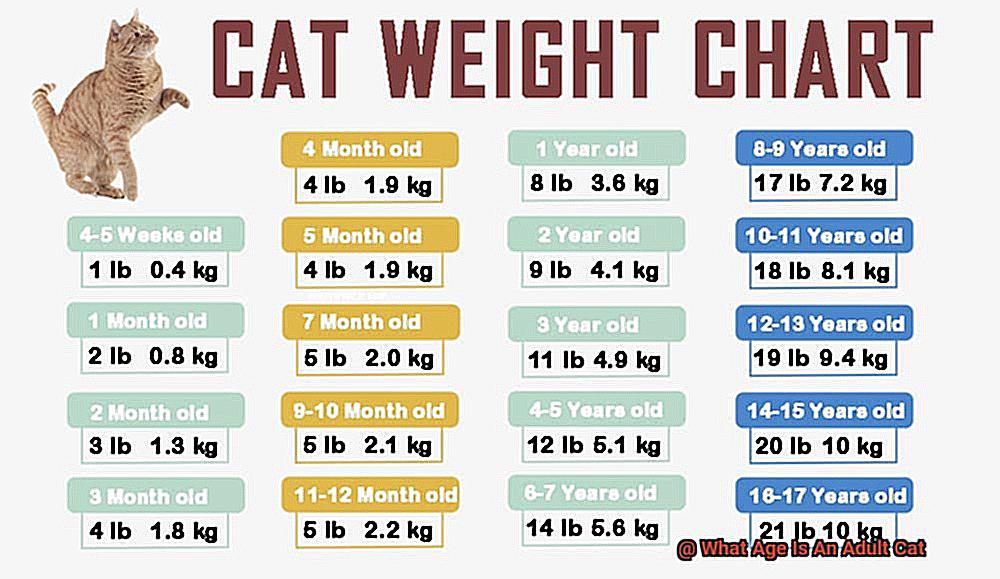Cats have been beloved pets for centuries, winning over human hearts with their soft fur, curious personalities, and affectionate nature.
But many cat owners wonder about the growth and development of their feline friends. “What age is an adult cat?”
is a common question that comes up. While there’s no definitive answer, most experts agree that cats become adults between the ages of one to two years old.
By this point, cats have generally stopped growing and reached sexual maturity. However, some breeds may mature earlier or later than others.
As cats transition into adulthood, they exhibit behavior that’s typical of adult cats: less jumping and more lounging around, as well as territorial habits like marking their territory. The shift from kittenhood to adulthood is gradual and subtle.
As responsible cat owners, we must watch for any changes in behavior to ensure our feline friends’ health and happiness. Knowing when our cats reach this significant milestone helps us provide better care and enjoy their companionship to the fullest.
So let’s dive in now.
Factors that Determine a Cat’s Maturity
While most cats are considered adults at 1 year of age, there’s more to the story than meets the eye.
Let’s take a closer look at the top three things that influence a cat’s growth: breed, environment, and genetics. Firstly, breed plays a significant role in determining when a cat reaches full maturity.
Different breeds have unique growth patterns, with some taking longer than others to mature. For instance, Maine Coon cats can take up to five years to reach their full potential, while Siamese cats may only need two years.
Knowing your cat’s breed and their typical growth pattern is crucial to understanding when they’ll reach adulthood. Secondly, environment is another key factor in determining a cat’s rate of maturity.
Providing your furry friend with an environment that includes a balanced diet, regular exercise, and socialization can help them grow and develop faster. On the other hand, if your cat lacks these essential elements, their development may be delayed.
By creating optimal living conditions for your cat, you can ensure that they reach their full potential both physically and mentally. Lastly, genetics also play a crucial role in determining when a cat reaches maturity.
Some cats have genes that cause them to mature more slowly than others, while others may have genes that result in faster maturation. Understanding your cat’s genetic background will help you predict when they’ll hit full maturity.
So, determining a cat’s maturity is not as simple as counting their age in years. The factors that influence their growth are multifaceted and complex, including breed, environment, and genetics.
When Do Cats Reach Adulthood?
Well, the answer is not so simple.
Cats are unique creatures with various factors that influence their growth patterns. From breed and size to gender and environment, many variables contribute to when a cat reaches adulthood.
In general, cats are considered adults after they reach one year of age. However, some breeds like Siamese and Burmese may take up to two years to fully mature.
Male cats also tend to take longer to develop than females, with some not reaching full maturity until they are three or four years old. During this time, male cats may exhibit territorial behavior and aggression towards other male cats.
But even though a cat may be considered an adult at one year of age, they may still exhibit kitten-like behavior for a few more months. This is because cats continue to develop and learn throughout their lives.

As they age, they become more independent and tend to calm down. By the time they reach three or four years old, most cats have settled into their adult personalities and routines.
However, every cat is unique and will develop at their own pace. Some cats may remain playful and energetic well into their senior years.
That’s why it’s crucial to schedule regular veterinary check-ups to ensure your cat is healthy and developing normally. In conclusion, while there isn’t a definitive answer to when cats reach adulthood, we do know that it varies by breed, gender, and individual characteristics.
Remember to cherish every moment with your fur baby, no matter what stage of life they’re in.
Male Cats vs Female Cats
Male cats tend to be larger and heavier than their female counterparts, with a more muscular build. They boast a broad head and a thick neck that exudes power and strength.
In contrast, female cats have a delicate bone structure and are typically lighter and shorter in size. Now, let’s delve into behavior.
Male cats are known for their territorial tendencies, which can sometimes lead to aggressive behavior towards other males. They may also mark their territory by spraying urine, which can be challenging to manage.
However, female cats are often more affectionate and can be better at socializing with other feline friends. Lastly, let’s discuss maturity.
Male cats usually reach physical maturity between 12 to 16 months of age, but they may continue to exhibit kitten-like behavior until they reach around two years old. On the other hand, female cats reach physical maturity around 8-12 months of age and become sexually active at this time.
To prevent unwanted litters and reduce the risk of certain health issues, it’s crucial to spay or neuter your cat before they become sexually active. Overall, both male and female cats can make fantastic pets.
However, it’s essential to consider their individual personalities and needs when selecting a cat that will fit well into your household. Whether you’re looking for a strong and confident male cat or a gentle and loving female cat, there’s a feline companion out there for everyone.
To ensure that your furry friend is healthy and thriving, it’s best to schedule regular veterinary check-ups.
Health and Nutrition Impact on Maturity
The growth and maturity of cats greatly depend on their health and nutrition.
A cat can only reach its full potential in terms of size, strength, and overall health if it is provided with adequate nutrition and proper healthcare. During the kitten stage, a balanced diet is especially crucial as it lays the foundation for healthy growth and development.
A diet that lacks essential nutrients can result in stunted growth, weak bones, and unhealthy muscles. On the other hand, a well-balanced diet rich in protein, fats, and essential vitamins and minerals helps kittens grow properly, build strong bones, and develop healthy muscles.
This enables them to face the challenges of adulthood with ease. Once a kitten reaches adulthood, maintaining a healthy diet that meets its nutritional needs is essential.
A well-balanced diet helps adult cats maintain optimal weight, reduces the risk of diseases such as diabetes, and promotes overall good health. In addition to proper nutrition, regular veterinary check-ups are equally important for maintaining a cat’s health.
These check-ups offer an opportunity for pet owners to discuss any concerns they may have about their cat’s health or behavior while veterinarians can spot any potential health issues early on before they become major problems.
So, providing your cat with appropriate nutrition and regular veterinary care is vital to ensure they reach their full potential in terms of size, strength, and overall wellbeing.

EHtPkOox1hc” >
Signs of an Adult Cat
Most cats reach adulthood between one to two years old, but there are specific signs that indicate when your cat has reached full maturity.

One physical sign of an adult cat is their weight. Around 12 months old, most cats will reach their full weight, usually between 8 and 10 pounds.
Keep in mind that males are typically smaller than females. Another physical sign of an adult cat is their teeth.
By the time a cat reaches adulthood, they will have all of their adult teeth, which are wider and sharper than their baby teeth. Behaviorally, adult cats tend to be less active and more independent than kittens.
They may spend more time sleeping and less time playing or seeking attention from their owners, which can lead to more snoozing. Adult cats also tend to be more territorial and will mark their territory by scratching or rubbing against objects in the home.
It’s important to note that some breeds may take longer to fully mature. For example, Maine Coon cats could take up to five years old before reaching full maturity.
From physical changes like weight and teeth to behavioral shifts such as independence and territoriality, recognizing these signs will ensure that your cat receives the proper care they need throughout their lives.
Also Read: Why Is My Cat So Small?
Conclusion
In conclusion, there’s more to determining when a cat is an adult than meets the eye.
While most felines reach adulthood between one and two years old, several factors come into play that impact their growth and development. These include breed, genetics, climate, fitness level, and diet.
It’s crucial to understand your cat’s unique characteristics and needs to provide them with optimal care throughout their lives. From physical changes like weight and teeth to behavioral shifts such as independence and territoriality, recognizing these signs will ensure that your cat receives the proper care they require.
To guarantee our furry companions’ health and happiness, we must monitor any behavior changes closely. Scheduling regular veterinary check-ups can also help identify potential health issues early on before they become significant problems.
So cherish every moment with your feline friend, no matter what stage of life they’re in.







